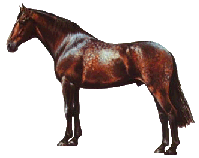|
|
Cleveland Bay |
|
|
|
Cleveland Bay |
|
 During the 16th and 17th Centuries in England, there were no roads between most smaller towns and villages. Travelers went either on foot or on horseback, and if there was a burden to carry, if had to be either on their own backs or on a horse's back! Merchants overcame the problem of transporting goods by producing a satisfactory pack horse and driving it from town to town loaded with goods. Medieval drawings portray these heavily burdened pack ponies and their masters. Ponies though they were, they were the forerunners of the Cleveland Bay, and through them a thriving business burgeoned.
During the 16th and 17th Centuries in England, there were no roads between most smaller towns and villages. Travelers went either on foot or on horseback, and if there was a burden to carry, if had to be either on their own backs or on a horse's back! Merchants overcame the problem of transporting goods by producing a satisfactory pack horse and driving it from town to town loaded with goods. Medieval drawings portray these heavily burdened pack ponies and their masters. Ponies though they were, they were the forerunners of the Cleveland Bay, and through them a thriving business burgeoned.
In the 1690s, these enterprising traveling salesmen, or merchants, were called Chapman's Horses. Later on they became known by the district of Cleveland, in the northeast quarter of Yorkshire's North Riding, from where they came from. From this, plus the description of their bay color, which never varied, came the name Cleveland Bay.
The Chapman Horse was the foundation for the modern Cleveland Bay, influenced by Andalusian and Barb blood in the late 17th Century. In later times, Thoroughbred blood was added, resulting in a powerful clean-legged horse able, as none other, to work heavy clay lands and to haul construction loads; a horse that could carry heavy men out hunting and was a notable jumper. Above all, of course, it was a coach horse unsurpassed by any other up to the reign of George II.
In the 19th Century, the improvements in road surfaces called for a faster horse, the Cleveland Bay was judged too slow for coaches able to travel at an average of 8-10 mph. As a result, the Yorkshire Coach Horse, a Thoroughbred/Cleveland Bay cross came into being. The Yorkshire Coach Horse was possibly the most popular harness horse of the 19th Century. This elegant and powerful horse became, to all intents, extinct and its stud book closed in 1936. But the Cleveland Bays was exported extensively all over the world and influenced the development of many European breeds.
After World War II, the breed went into decline, and in 1926 only 4 mature stallions remained in Britain. Thanks to Queen Elizabeth II, the breed survived, because she made available the stallion Mulgrave Supreme, originally destined to be sold to America. Her stallion proved to be a remarkable rejuvenating influence. He was so successful that by 1977, there were 15 stallions, most of them his progeny.
The Cleveland remains an important cross with the Thoroughbred to produce jumpers, hunters and superb carriage horses. It transmits to all of these size, bone, a hardy construction, stamina and strength. Clevelands are among the longest-lived, and they are very fertile.
 Most Cleveland Bays stand between 16 and 16.2 hand. They are always
bay with black points, and never have more than a small white star on their head, any more white indicating outside blood. Their heads still display some characteristics that are reminiscent of the
Andalusian ancestors. Though the modern Cleveland Bay is lighter that its predecessors, it is especially powerful in its neck and through the shoulder. The quarters are big enough to carry a heavyweight "over a house." With second thighs, hocks and fetlock joints match, with clean legs, without feather, are an essential feature of the breed. They allow the horse to work in the heavy clay of Northeast England and to jump out of some of the most deep going to be found in any hunting country.
Most Cleveland Bays stand between 16 and 16.2 hand. They are always
bay with black points, and never have more than a small white star on their head, any more white indicating outside blood. Their heads still display some characteristics that are reminiscent of the
Andalusian ancestors. Though the modern Cleveland Bay is lighter that its predecessors, it is especially powerful in its neck and through the shoulder. The quarters are big enough to carry a heavyweight "over a house." With second thighs, hocks and fetlock joints match, with clean legs, without feather, are an essential feature of the breed. They allow the horse to work in the heavy clay of Northeast England and to jump out of some of the most deep going to be found in any hunting country.
American breeders are promoting the Cleveland Bay today through
The Cleveland Bay Horse Society of North America at
For more information on the Cleveland Bay, also visit:
Look for an update of this article.
Original version published December 1993 in NorthWest Breyer Horse Club Newsletter. (ma/em)

© 1997-2007
NW Breyer Horse Club
& Refiner of Gold Creations
Equinealities in place since 1997,
Section in place 2001,
Updated 3/13/2007




